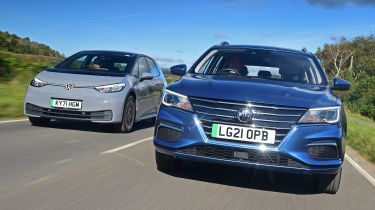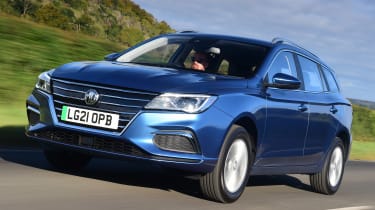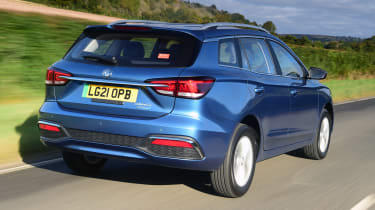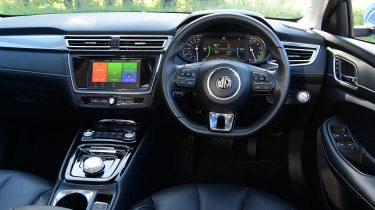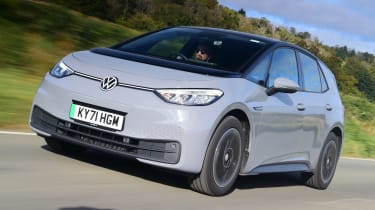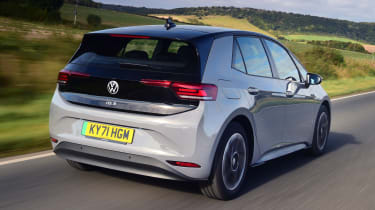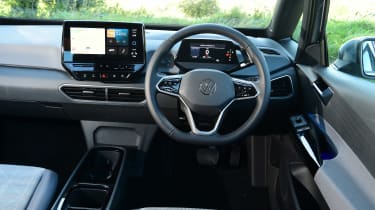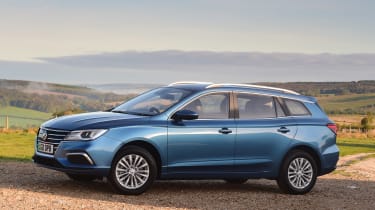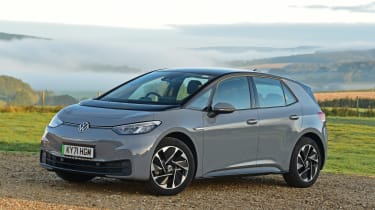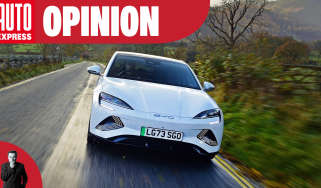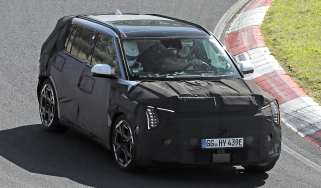MG5 vs Volkswagen ID.3: 2022 twin test review
Entry-level electric cars from MG and Volkswagen go head to head to see which offers the best overall value for money
Early adoption of new tech has its costs – literally. Whether it’s the latest big TV, new smartphone, or a fridge that’s intelligent enough to order itself a block of cheddar when you’re running low, it takes time before gadgets become affordable for the masses.
The same applies to electric cars. But with EVs breaching the tipping point of universal appeal, some genuinely great low-cost EVs are hitting the market, such as the MG5. This down-to-earth EV is also unique, because it’s the only electric estate on the UK market – as long as you call the Porsche Taycan Sport Turismo a ‘shooting brake’.
Its closest rival is the Volkswagen ID.3. This model kick-started the firm’s electrification drive, and in entry-level form (the 45kWh model has been pulled from price lists temporarily) it is a close match for MG’s straight-laced wagon. So does the modern-looking hatch bring with it a more modern driving experience? Or can the MG throw up a surprise?
MG5
| Model: | MG5 EV Exclusive Long Range |
| Price: | £30,445 |
| Powertrain: | 61.1kWh battery, single motor, 154bhp, front-wheel drive |
| 0-62mph: | 7.3 seconds |
| Test economy: | 3.8mi/kWh |
| WLTP Range: | 250 miles |
| Annual road tax: | £0 |
As proof of just how competitively priced the MG5 is, it’s possible to hop into a top-spec model for comfortably less than the most affordable ID.3 currently available. Here, the Long Range Exclusive model is priced at £30,445; add the Piccadilly Blue paint of our version and the total is £30,990.
Used - available now

2019 BMW
1 Series
55,000 milesAutomaticPetrol1.5L
Cash £14,690
2022 Kia
e-Niro
23,188 milesAutomaticElectric
Cash £14,500
2023 Vauxhall
Corsa
7,145 milesManualPetrol1.2L
Cash £11,567
2023 Tesla
Model 3
35,546 milesAutomaticElectric
Cash £18,300Design & engineering
When MG was reintroduced to the UK under Chinese ownership, the brand ticked along with modest sales without troubling any of the market leaders. That all changed with the release of its electric family, however; the MG ZS EV offers buyers an affordable family SUV, and the MG5 estate takes an even more rational approach.
It might be too sensible for some, though. The exterior design is plain, while the jacked-up ride height – a necessity to fit in this model’s 61.1kWh battery without compromising interior space – makes it look a little awkward.
Much like the outside, the MG5’s cabin is rather unremarkable to look at. The layout is neat and functional, but is a little dated by the standards of most new cars, let alone the ID’3’s contemporary finish. It’s no surprise to learn that digital dials aren’t on the agenda here; instead there’s a pair of analogue clocks split by a small LCD screen providing the standard trip info. The driving position is quite high even in its lowest setting, so taller drivers might feel a little perched up when they try to find their ideal position.
Power is catered for by a single electric motor with 154bhp and 260Nm, which drives the front wheels.
Driving
Although the MG5’s cabin shows signs of its budget price tag, the way it drives feels anything but. There’s nothing outstanding about its performance, but for its intended purpose, there are no glaring flaws, either. The modest 16-inch wheels mean that, at low speeds in particular, the MG is relaxing and comfortable to drive, and it’s backed up by light steering.
Head out of town and the MG doesn’t feel quite as sophisticated as the VW. This is most obvious over big bumps, where it gets thrown about more than its rival. The chassis feels more nose-heavy in corners and grip is slightly lower, too. Still, driven at a relaxed pace, the MG5 is more than good enough.
Performance in a straight line is lively. The mix of front-wheel drive and that instant burst of torque from the electric motor means that it’s more than capable of spinning the front tyres if you’re keen with the accelerator away from a standstill. With its fairly understated looks, the MG5 is quite an unlikely car to outsprint others away from a set of traffic lights.
Practicality
Being an estate car, a spacious boot is to be expected. While the MG5 has the ID.3 easily covered – a 464-litre space beats the VW’s 385 litres – it’s a figure that’s some way off similarly sized combustion-powered wagons, such as the VW Golf Estate, which break the 600-litre mark. Part of the problem is that the MG5 is relatively short for an estate, although at 4,544mm long, it’s still 283mm longer than its rival here.
There are other compromises, too, such as a high load lip that leaves a step down to the boot floor, while the rear seats don’t fold anywhere near flat. At this point the total volume climbs to 1,456 litres, which is 189 litres more than in the ID.3, but we still think it’s best to view the MG5 as a very roomy hatchback, rather than a fully fledged wagon.
There’s no dedicated storage for the Type 2 charging cable, either, so that has to sit in the boot along with anything else you need to carry.
While front-seat occupants sit high, those in the back will feel even more perched. Still, there’s enough headroom and it means children will benefit from a decent view out. The floor is quite flat, too, but there is little space to tuck feet under the front seats.
Ownership
One area where MG has plenty of room for improvement is with customer satisfaction. Owner feedback in our 2021 Driver Power survey ranked the brand the lowest of the 29 manufacturers included. VW didn’t cover itself in glory with a 17th- place finish in the same poll, but it’s still significantly ahead of its rival here.
The MG claws back some ground thanks to a strong seven-year warranty, though; in contrast the ID.3 gets just three years of cover, although its battery is protected for eight years or 100,000 miles of driving, whichever comes first.
Running costs
In much the same way that a combustion-powered car can struggle to match its official WLTP economy figures in the real world, a similar rule of thumb applies to an electric car and its official range. However, in mild conditions, both of these cars didn’t fall too far short of their claimed totals.
The VW was the more efficient of the two; its 4.4 miles per kilowatt-hour figure meant a real-world range of 252 miles – only eight miles less than the WLTP claim. Based on home charging at a unit price of 18.9p per kWh, that translates to an electricity cost of £869 over 20,000 miles.
The MG returned 3.8mi/kWh, which means a cost of £995 for 20,000 miles of home charging. At that level of efficiency, the MG should cover 232 miles between top-ups, which is still a perfectly usable number for long journeys. Of course, these costs will go up when using pricier public charging, and will also rise when home energy tariffs increase in April.
Zero CO2 emissions mean ultra-low company car costs. A higher-rate taxpayer can expect annual Benefit-in-Kind deductions of £128 in the 2021/22 financial year for the MG, with the VW costing one pound extra.
Testers’ notes: “The KERS button will strike a chord with F1 fans, and the acronym is the same: the Kinetic Energy Recovery System adjusts brake regeneration.”
Volkswagen ID.3
| Model: | Volkswagen ID.3 Life Pro |
| Price: | £32,200 |
| Powertrain: | 58kWh battery, single motor, 143bhp, rear-wheel drive |
| 0-62mph: | 9.6 seconds |
| Test economy: | 4.4mi/kWh |
| WLTP Range: | 260 miles |
| Annual road tax: | £0 |
In these pictures we have an ID.3 in Life trim with a 45kWh battery. However, sales of this entry-level model have temporarily stopped, so we are testing the MG5 against the model with the next battery size up. At 58kWh, it means the ID.3 has a capacity that’s nearly a match for the MG. The price is higher, though, starting from £32,200.
Design & engineering
Over the last couple of years, the VW Group’s MEB architecture designed for electric vehicles has arrived on the market in a variety of shapes and sizes. The ID.3 was the first, and in many ways, it’s still the most pragmatic of the bunch.
Here it’s facing the MG in possibly its most no-nonsense arrangement: the powertrain option named ‘Pro’ uses a single motor that produces 143bhp and 310Nm, and it’s paired with a 58kWh battery. That’s enough for a 260-mile range according to official WLTP figures – 10 miles further than the MG5, despite a slightly smaller battery pack.
Those who wish for more power or more range, can look higher up the ID.3 pecking order. The Pro Performance gets a more potent motor, which lifts the overall output to 201bhp – slashing the 0-62mph time from the 9.6 seconds of the Pro model down to 7.3 seconds. The Pro S variant gets the same 201bhp motor, but also a larger 77kWh battery, which claims up to 338 miles between charges.
Both inside and out, the ID.3 looks minimalist, understated and certainly more contemporary than its rival. Although it seems crisp and modern, some aesthetic choices seem to have been made to the detriment of functionality. Take the temperature controls; located along a small shelf beneath the touchscreen, they’re exactly where you’d wish to steady your hand while using the screen, so you often accidentally press them. Bizarrely, these controls aren’t backlit either, so you can’t see how to adjust the temperature at night.
Unlike its rival, the ID.3 has a fully digital driver’s display. It’s small compared with other similar systems, at 5.3 inches, but it offers all the useful information that you need. It adjusts with the steering wheel too, so it’s always perfectly positioned.
Driving
One of the most remarkable things about the ID.3 is, ironically, just how unremarkable it feels to drive. The weighting and responses of all the controls feel near-identical to those of a petrol or diesel Golf, so despite the completely different powertrain, loyal VW buyers moving from ICE to EV shouldn’t feel in the slightest bit intimidated.
Beside the MG, the ID.3’s more sophisticated body control makes it feel more stable and relaxing on the move, but the VW’s 18-inch wheels – two inches larger than the MG’s – offer subtle differences in ride comfort. At lower speeds, the VW tends to thump into potholes and larger imperfections slightly more – although still not harshly – and the tyres generate a slightly bassier rumble on the road. But at higher speeds the ID.3 has the edge in terms of comfort.
It backs this up with a superior balance through the corners. That stability is paired with very little steering feedback, meaning that it would be a stretch to call it fun, but it’s very competent and inspires more confidence than the MG.
It’s not as quick as its rival, though, which is reflected in a 0-62mph time of 9.6 seconds, 2.3 seconds slower than the 5 EV. Still, the ID.3 feels perfectly sprightly enough for family car duties.
Practicality
The ID.3’s clever packaging is immediately obvious to rear-seat passengers. Kneeroom in particular is excellent; there’s roughly 50mm more here than in the MG. In fact it’s among the best of any car with a similar footprint, regardless of powertrain. There’s more space for feet under the front seats, too, while there’s very little between the two in terms of headroom.
Both cars have fairly wide middle seats, and both have Isofix points that are easy to reach, although the plastic housings of the VW’s are a neater solution and less likely to damage the surrounding seat upholstery. The ID.3 also benefits from a third pair of Isofix mounts on the front passenger seat.
A tall console between the front chairs has two deep storage bins and a couple of cup-holders, which, combined with generous door bins, make the VW much better than the MG for cabin storage.
Ownership
A maximum five-star safety rating was awarded to the ID.3 when it was tested in 2020 – its 89 per cent score for the child occupant protection category was the highest of any car tested that year. The MG5 hasn’t yet been assessed by NCAP, but MG has received strong scores with its other EV, the ZS; the brand’s SUV also achieved a five-star rating.
There’s little to separate the pair when it comes to charging. Find a source quick enough and both will accept a 100kW supply. This translates into a 10-80 per cent top-up in 33 minutes for the VW; the MG takes slightly longer thanks to the extra 3.1kWh of battery capacity it has.
A similar result applies when they’re plugged into a home wallbox; both should dip below the nine-and-a-half hour mark for a full charge, which is ideal if you come home and plug in overnight.
Running costs
One advantage of a badge that is perceived to carry more desirability is that the VW ID.3 is predicted to benefit from stronger residual values than the MG. After three years, the ID.3 is expected to hold on to 54.7 per cent of its value, compared with the MG’s 48.4 per cent. That means that the VW should cling on to £1,123 more of its original retail price after 36 months have passed.
Testers’ notes: “Most of the ID.3 range gets 18-inch plastic wheel trims as standard. If you’re searching for more style, optional alloys range from £660 to £1,810 extra.”
Verdict
First place: MG5
This verdict could quite easily have swung in either direction, but if we focus on value for money and load capacity above all else, then the MG takes the win. Monthly finance rates undercut its rival by more than enough to balance out the ID.3’s superior efficiency, while the MG is perfectly fine to drive and appreciably faster than its rival. As it stands, you can’t get more EV for the money than this.
Second place: Volkswagen ID.3
Settling for second here doesn’t mean there’s no appeal to the entry-level ID.3. It’s more efficient than the MG, roomier for passengers, and slightly better to drive. But based on price, boot space and kit levels, it plays second best. It’d only take improved in-car tech and better ergonomics for us to consider the extra purchase price justified for the VW, though.
Is it worth waiting for this model?
MG5
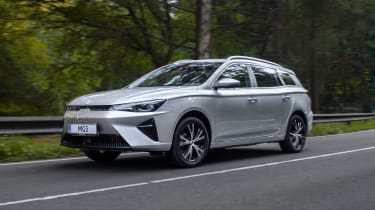
- Due: Spring
- Price: £27k (est)
- Battery: 50.3kWh
A revised MG5 is due this year. It gets a sharper look, and MG says cabin quality and infotainment will be improved. Expect a lower price, too, with the arrival of a smaller 50.3kWh battery option.
Figures
| MG5 EV Exclusive Long Range | Volkswagen ID.3 Life Pro | |
| On the road price/total as tested | £30,445/£30,990 | £32,200/£32,200 |
| Residual value (after 3yrs/36,000) | £14,748/48.4% | £17,626/54.7% |
| Depreciation | £15,697 | £14,574 |
| Annual tax liability std/higher rate | £64/£128 | £64/£129 |
| Annual electricity cost (12k/20k miles) | £597/£995 | £521/£869 |
| Insurance group/quote/road tax cost | 27/£465/£0 | 18/£455/£0 |
| Servicing costs | N/A | £12.87pm (2yrs) |
| Length/wheelbase | 4,544/2,659mm | 4,261/2,765mm |
| Height/width | 1,521/1,818mm | 1,568/1,809mm |
| Powertrain | Single e-motor/lithium-ion battery | Single e-motor/lithium-ion battery |
| Peak power | 154bhp | 143bhp |
| Peak torque | 260Nm | 310Nm |
| Transmission | Single-speed/fwd | Single-speed/rwd |
| Battery capacity/usable | 61.1/61.1kWh | 58/58kWh |
| Boot capacity (seats up/down) | 464/1,456 litres | 385/1,267 litres |
| Kerbweight/towing capacity | 1,565/N/A | 1,781/N/A |
| Turning circle | 11.3 metres | 10.2 metres |
| Basic warranty (miles)/recovery | 7yrs (80,000)/1yr | 3yrs (60,000)/3yrs |
| Driver Power manufacturer/dealer pos. | 29th/N/A | 17th/16th |
| NCAP: Adult/child/ped./assist/stars | N/A | 87/89/71/88/5 (’20) |
| 0-62mph/top speed | 7.3 secs/115mph | 9.6 secs/99mph |
| Auto Express economy | 3.8 miles/kWh | 4.4 miles/kWh |
| Auto Express predicted range | 232 miles | 252 miles |
| Claimed range (WLTP) | 250 miles | 260 miles |
| Charging capability | 7/100kW | 7/100kW |
| Charging time | 9h 30min/40min* | 9h 15min/33min+ |
| Claimed CO2/tax bracket | 0g/km/1% | 0g/km/1% |
| Airbags/Isofix/park sensors/camera | Yes/yes/rear/yes | Yes/yes/f&r/no |
| Auto/lane-keep/blind spot/AEB | Yes/yes/no/yes | Yes/yes/no/yes |
| Climate control/adaptive cruise | Yes/yes | Yes/yes |
| Leather/heated seats | No^/yes | No/yes |
| Metallic paint/LED headlights | £545/no | £665/yes |
| Keyless entry/power tailgate | Yes/no | Yes/no |
| Nav/digital dash/DAB/connected apps | Yes/yes/yes/no | Yes/yes/yes/yes |
| Wireless charge/CarPlay/Android Auto | No/yes/yes | Yes/yes/yes |
